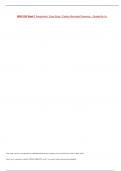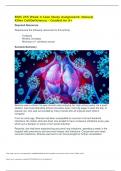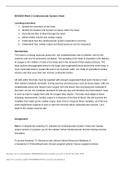Bios 255 week 3 case - Study guides, Class notes & Summaries
Looking for the best study guides, study notes and summaries about Bios 255 week 3 case? On this page you'll find 27 study documents about Bios 255 week 3 case.
Page 2 out of 27 results
Sort by

-
BIOS 255 Week 7 Assignment: Case Study I Carbon Monoxide Poisoning – Graded An A+
- Case • 3 pages • 2024
- Available in package deal
-
- $13.99
- + learn more
BIOS 255 Week 7 Assignment: Case Study I Carbon Monoxide Poisoning – Graded An A+ 1. Carbon monoxide binds to hemoglobin more than oxygen due to its greater affinity for hemoglobin. When exposed t o Carbon monoxide oxygen cant bind to hemoglobin resulting in lack of oxygen throughout the body. 2. The pulse oximeter is a noninvasive device typically used to measure the saturation of oxygen in a patient’s blood. This is different from a CO- Oximeter which is used to measure levels of carboxyhe...

-
BIOS 255 Week 2 Assignment: Detailed Case Study on the Functioning of the Heart Including Accurate Responses to Questions
- Other • 4 pages • 2024
- Available in package deal
-
- $13.49
- + learn more
BIOS 255 Week 2 Assignment: Case Study – Heart – With Correct Answers What are the four valves found in the heart and where are they located? Give all names for each valve. “Tricus pid valve: located between the right atrium and the right ventricle. pulmonary semilunar valve: located between the right ventricle and the pulmonary artery. Mitral valve: located between the left atrium and the left ventricle. Aortic semilunar valve: located between the left ventricle and the aorta. (Tortora, 2...

-
BIOS 255 Week 4 Case Study Assignment: Natural Killer Cell Deficiency – Graded An A+
- Other • 3 pages • 2024
- Available in package deal
-
- $11.99
- + learn more
BIOS 255 Week 4 Case Study Assignment: Natural Killer Cell Deficiency – Graded An A+ Required Resources Read/review the following resources for this activity: • Textbook • Weekly Concepts • Minimum of 1 scholarly source Scenario/Summary Shanice was a vibrant 16-year-old who was enjoying her high school years. As a good student, she loved attending school and woke every morning eager to start the day. A popular girl, she was surrounded by many friends who all enjoyed each other's company...

-
BIOS 255 Week 3 Case Study-Hypoproteinemia
- Case • 4 pages • 2022
- Available in package deal
-
- $8.49
- + learn more
BIOS 255 Week 3 Case Study-Hypoproteinemia

-
BIOS 255 Week 3 Case Study; Hypoproteinemia
- Other • 3 pages • 2022
- Available in package deal
-
- $20.49
- + learn more
1. Describe all the constituents contained in plasma and their concentrations. 2. Explain the liver’s role in production of proteins. 3. Why would albumin be important in regulating pressure atthe capillaries? 4. Explain the process of fluid movement at both the arterialand venous side of the capillary. 5. What can Betty do to improve her situation?

-
BIOS-255 Week 3 Assignment: Case Study – Hypoproteinemia (graded)
- Case • 4 pages • 2022
- Available in package deal
-
- $10.99
- + learn more
Week 3 Case Study: Hypoproteinemia Chamberlain University BIO255 Describe all the constituents contained in plasma and their concentrations. As we look at the co mponents of blood, the 55% that consists of plasma includes water which serves as a solvent for carrying other substances, Ions, such as sodium, potassium, calcium, magnesium, chloride, and bicarbonate that involve osmotic balance, pH buffering and the regulation of membrane permeability (Bertholf, 2014). The plasma also consists of the...

-
BIOS 255 Week 1-Week 7 Case Studies (BUNDLED)/ (100% Correct)
- Package deal • 6 items • 2022
-
- $15.49
- + learn more
BIOS 255 Week 2 Case Study-The Heart | Download To Score An A 2 CASE BIOS 255 Week 3 Case Study-Hypoproteinemia 3 CASE BIOS 255 Week 4 Case Study-Natural Killer Cell Deficiency (GRADED) 4 CASE BIOS 255 Week 5 Case Study-Hypersensitivity Reactions. (GRADED A) 5 CASE BIOS 255 Week 7 Case Study-Carbon Monoxide Poisoning (GRADED A) 6 CASE BIOS 255

-
BIOS 255 Week 1 Case Study-Coagulation (GRADED A)
- Case • 6 pages • 2022
-
- $10.99
- + learn more
BIOS 255 Week 1 Case Study-Coagulation 1.Discuss which clotting factors the PT and PTT test evaluate and whether each test measures the intrinsic or the extrinsic pathways. 2.Describe the common coagu lation pathway. 3.Based on Jessie’s test, which factor deficiency do you believe he has and why? 4. Jessie’s clotting factor disease is seen more often in males. Please explain why. 5.If both the PT and the PTT tests were abnormally long, which part of the coagulation pathway would be affected?...

-
BIOS 255 Week 2 Case Study-The Heart | Download To Score An A
- Case • 5 pages • 2022
- Available in package deal
-
- $10.99
- + learn more
BIOS 255 Week 2 Case Study-The Heart 1.What are the four valves found in the heart and where are they located? Give all names of each valve. 2.What is a mitral valve prolapse and what causes this in M arfan’s syndrome specifically? 3.What happens to blood flow (specifically) with a mitral valve prolapse (where would the blood back up to and why)? 4.If a person were to have a prolapse of the tricuspid valve, what specifically would happen to the flow of blood in that case? 5.Do you think Janet ...

-
BIOS 255 Week 5 Case Study-Hypersensitivity Reactions. (GRADED A)
- Case • 4 pages • 2022
- Available in package deal
-
- $10.99
- + learn more
BIOS 255 Week 5 Case Study-Hypersensitivity Reactions. 1.Manuel is experiencing a hypersensitivity reaction. What are hypersensitivity reactions? 2.Briefly describe the different types of hypersensiti vity reactions. 3.What type of hypersensitivity reaction is Manuel likely experiencing and how do you know? 4.Is this an antibody or T-cell mediated response? What class of antibodies or type of T- cells are involved? 5.Why was epinephrine administered and how does epinephrine work in this case? Sh...

How much did you already spend on Stuvia? Imagine there are plenty more of you out there paying for study notes, but this time YOU are the seller. Ka-ching! Discover all about earning on Stuvia


